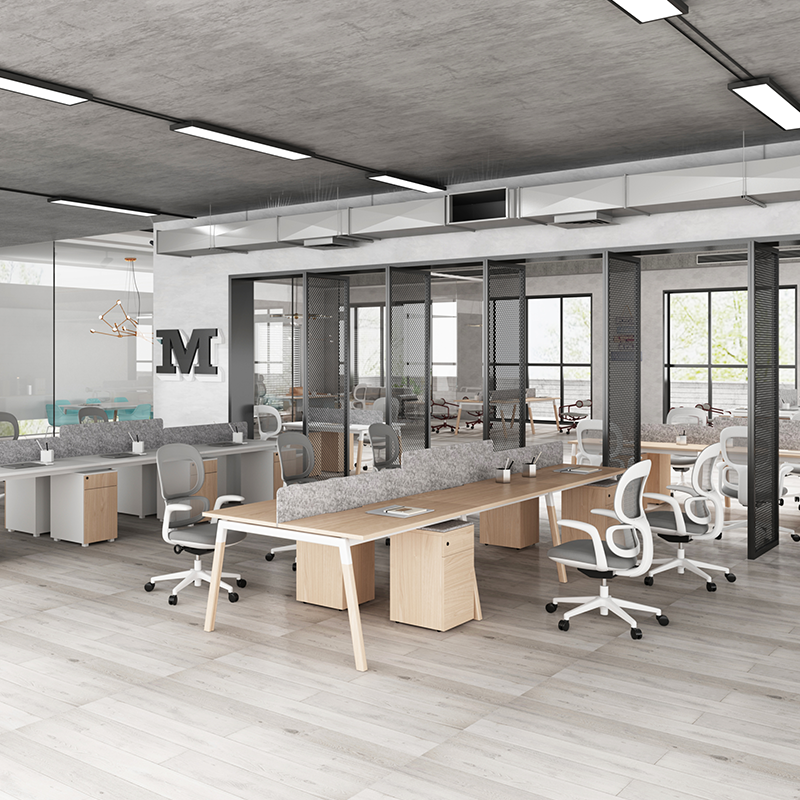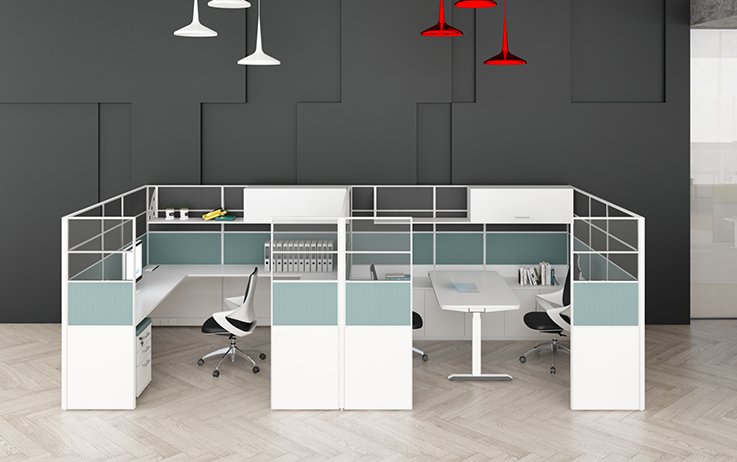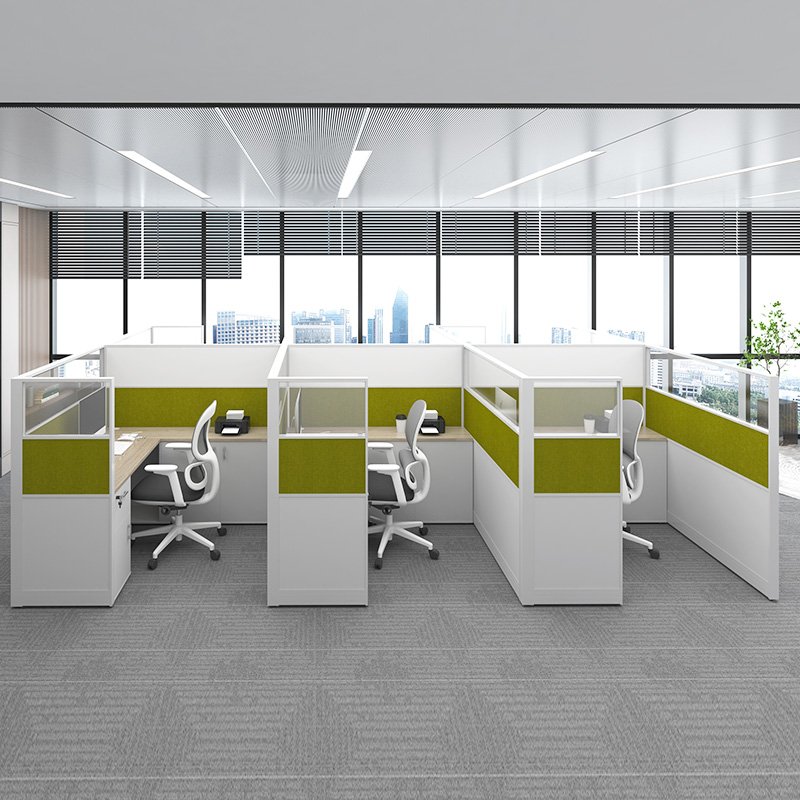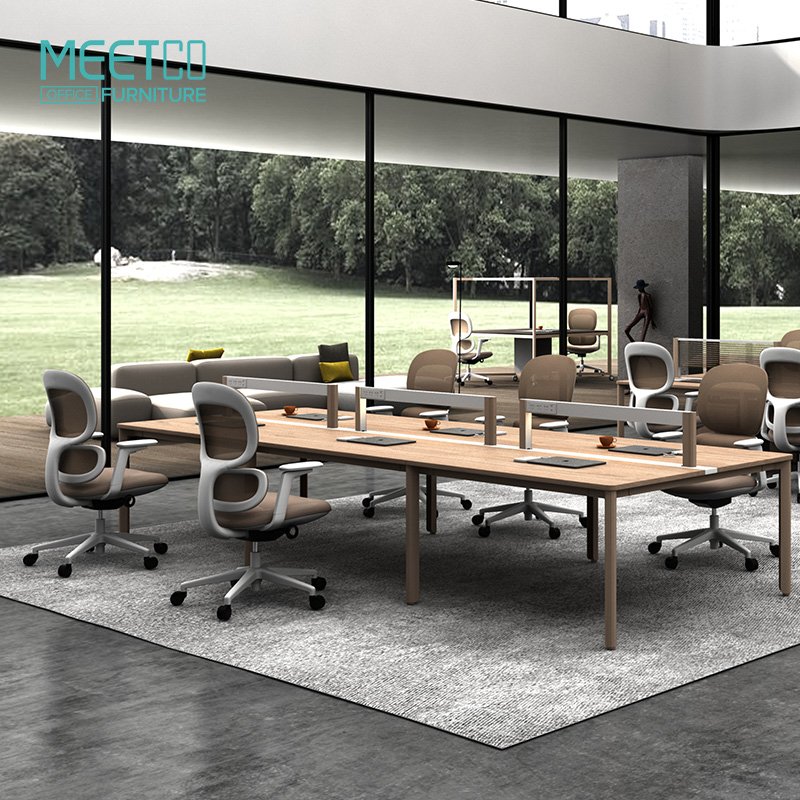In the ever-evolving world of office design, finding the perfect balance between productivity, comfort, and aesthetics is a constant challenge. Often, the solutions boil down to the choice of furniture, primarily the office workstations. Among the popular choices are benching systems and office cubicles. But which one is better? Which one will suit your office needs? This blog post will delve into the detailed exploration of both benching systems and office cubicles, including their types, features, pros and cons, and decisive factors for the choice between them.
1. What are benching systems?
Benching systems are a modern approach to workplace design, emphasizing open, collaborative spaces. They are essentially large tables, or ‘benches’, where multiple employees can work side-by-side, with minimal physical barriers between them.

Types of Benching Systems:
Broadly, benching systems can be categorized into two types: Fixed Benching Systems and Modular Benching Systems. Fixed benching systems are stationary, with a fixed layout, and are ideal for stable teams that don’t require frequent changes in the seating arrangement. On the other hand, Modular benching systems offer flexibility. They consist of individual components that can be rearranged as needed, allowing for a more dynamic and adaptable workspace.
Pros of Benching Systems:
- Space Optimization: Benching systems are compact and efficient, allowing for the usage of office space in the most economical way. This trait makes them ideal for smaller offices or startups where space is at a premium.
- Collaboration and Teamwork: By their very nature, benching systems promote a collaborative work environment. The open layout encourages communication, idea sharing, and teamwork, aligning perfectly with Meet&Co Office Furniture’s value of sharing to achieve the extraordinary.
- Cost-effectiveness: Benching systems tend to be more cost-effective than traditional office cubicles. The streamlined design and shared components reduce the cost per employee.
- Aesthetic Appeal: With their modern design and sleek appearance, benching systems can greatly enhance the aesthetic appeal of an office, creating a vibrant and energetic workspace.
Cons of Benching Systems:
- Lack of Privacy: The openness of a benching system can be a double-edged sword. While it promotes collaboration, it can also result in a lack of privacy. This can sometimes lead to distractions and a decrease in productivity for some employees.
- Noise Levels: Without the barriers that cubicles provide, noise can easily travel across the office, potentially disrupting concentration and productivity.
- Limited Personal Space: In a benching system, employees have limited personal space. While this can encourage collaboration, it may also lead to potential discomfort among employees who prefer having their own distinct workspace.
- Storage Challenges: Benching systems typically offer less storage space compared to traditional office cubicles. This may require additional storage solutions, potentially increasing overall costs.
2. What are Office Cubicles?
Office cubicles, also known as cubicle workstations, modular workstations, or simply cubicles, are semi-enclosed spaces in an office separated from neighboring workspaces by partitions. They were designed as an alternative to traditional open offices, providing employees with a degree of privacy while maintaining the ease of communication.

Types of Office Cubicles:
There are three main types of office cubicles, each with its unique characteristics:
- Full-Height Cubicles: Full-height cubicles are essentially small offices. They provide maximum privacy while minimizing noise and distractions. They’re best suited for work that requires high concentration levels.
- Semi-Private Cubicles: These are the most commonly seen in open-plan offices. They offer a balance between privacy and collaboration. They’re high enough to offer some degree of privacy but low enough to encourage interaction.
- Open Cubicles: Open cubicles have low or no partitions and are designed to foster communication and collaboration. They’re suitable for teams that frequently need to communicate and collaborate.
Pros of Office Cubicles:
- Increased privacy: Cubicles offer more privacy than benching systems, which can lead to improved focus and productivity.
- Noise reduction: The walls of the cubicles can block out noise from the surrounding environment, leading to fewer distractions.
- Personalization: Employees can personalize their space to create a comfortable working environment.
Cons of Office Cubicles:
- Limited communication: While cubicles offer privacy, they can also limit spontaneous communication between employees.
- Less flexible: Cubicles are less adaptable compared to benching systems. They can be difficult to reconfigure or move.
- More expensive: Cubicles generally cost more than benching systems due to the additional materials used for partitions and other elements.
3. How to Choose Between Benching Systems and Office Cubicles
When choosing between benching systems and office cubicles, it’s important to consider several key factors. The decision you make can significantly impact employee morale, productivity, and overall office aesthetic. Here are some crucial aspects to take into account:
- Nature of Work: The type of work your employees do can significantly influence the choice between a benching system and office cubicles. For instance, if your team consists of creatives who need to collaborate and communicate frequently, the open concept of benching systems may be more beneficial. Conversely, for jobs requiring high concentration and privacy, such as in a law firm or financial institution, office cubicles might be a better fit.
- Company Culture: Your office design should reflect your company culture. If your organization promotes a culture of teamwork, openness, and collaboration, a benching system might be preferable. However, if your company values privacy, individual focus, and quietness, office cubicles may offer a more suitable environment.
- Budget: Cost is always a deciding factor in any purchase decision. Benching systems are often more cost-effective as they require fewer materials to construct and can accommodate more employees per square foot than cubicles. However, office cubicles provide more individual workspace and privacy, which can justify their higher price point.
- Space Efficiency: The size of your office will also play a role in your decision. If you have a small office area, benching systems can optimize the use of space, enabling you to accommodate more employees. On the other hand, office cubicles, while requiring more space, can provide a more organized and personalized workspace for each employee.
- Employee Comfort and Satisfaction: Lastly, always consider the comfort and satisfaction of your employees. Some may prefer the privacy and personal space provided by cubicles, while others may thrive in the collaborative environment fostered by benching systems. You could consider surveying your team to get a sense of their preferences.
Remember that there’s no one-size-fits-all solution when it comes to office furniture. The best choice will depend on the specific needs and preferences of your organization and employees. So, take the time to assess these factors carefully before making your decision.
4. A Detailed Comparison between Benching Systems and Office Cubicles
When choosing the right office configuration, it’s essential to consider two popular solutions: benching systems and office cubicles. Here, we offer a detailed comparison of these two furnishing solutions concerning space optimization, privacy, collaboration opportunities, cost-effectiveness, and aesthetic appeal.

- Space Optimization: Benching systems are known for their space-saving capabilities. They typically involve long, shared tables where employees sit side-by-side or opposite each other, maximizing floor space utilization. On the other hand, office cubicles, while still economical on space, take up slightly more room due to the partitions and individual workstations.
- Privacy: In terms of privacy, office cubicles are the clear winner. They are designed to give each worker their own personal space, reducing distractions and noise levels. Conversely, benching systems offer less privacy due to the open layout, which might affect concentration levels for some employees.
- Collaboration Opportunities: If fostering teamwork and collaboration is a priority for your organization, benching systems may be the way to go. The open design promotes communication and interaction among team members, a feature not as present in traditional cubicle setups.
- Cost-Effectiveness: When comparing the cost, benching systems tend to be more economical since they require less material and are easier to install. Cubicles, while offering more privacy and personal space, are generally more expensive due to the additional components like partitions and individual workstations.
- Aesthetic Appeal: Aesthetically, both systems have their unique appeal. Benching systems offer a modern, clean, and collaborative vibe, whereas cubicles provide a more traditional, individualized workspace. Choosing between the two will depend on the image your company wants to portray.
5. Best Benching Systems and Office Cubicles to Consider
When it comes to optimizing your office space, there are several high-quality, innovative solutions available on the market. Here are some of the best office workstation solutions you might want to consider:
Reco Modular Office Workstations

Designed with adaptability in mind, Reco’s modular workstations feature a larger workspace perfect for a collaborative environment. The modular design makes it easy to customize layouts and accommodate different team arrangements. Each workstation comes with mobile filing cabinets, providing ample storage space without compromising the clean, organized look of the office.
Mindful Modular Benching Desks
If you’re aiming for a minimalist yet functional office environment, Mindful’s modular benching desks could be an excellent choice. Adorned with a pleasing wood grain finish, these desks exude a sense of calm and tranquility. They are equipped with desk panels for a level of privacy and mobile filing cabinets for easy access to office files and documents.
Aston Office Cubicles

Ideal for offices that prioritize privacy and productivity, Aston’s office cubicles feature high partitions to reduce noise and distractions. The cubicles come with built-in storage cabinets, providing both convenience and a neat workstation. The height-adjustable desks with presets are the cherry on top, allowing employees to alternate between sitting and standing for a healthier workstation.
Conclusion
Deciding between benching systems and office cubicles can be challenging as both have unique features that cater to different office needs. However, by considering your company’s work nature, culture, and budget, you can arrive at the most suitable choice.
Looking to revamp your office space? Visit Meet&Co Office Furniture for a wide range of modern, high-quality office furniture solutions guaranteed to transform your workspace into a hub of creativity and productivity.



